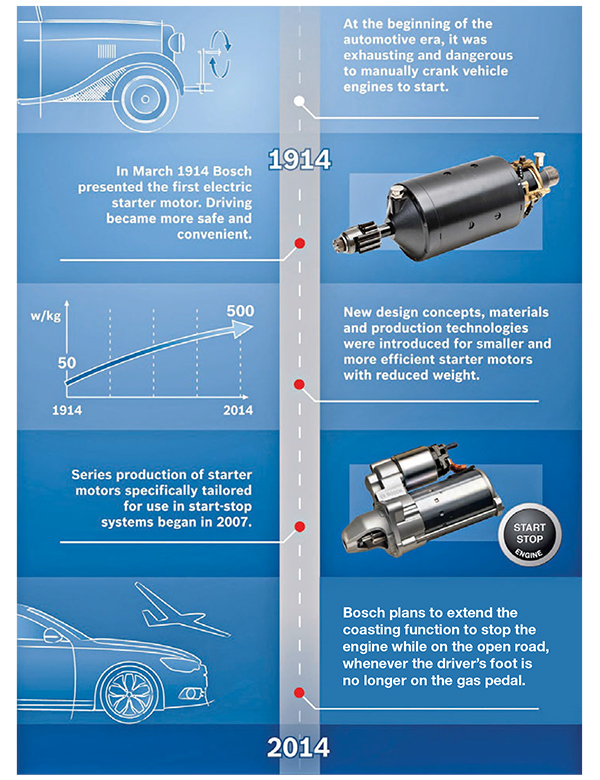 A century ago, in March 1914, Bosch presented its first electric starter motor for automobiles; manufactured at the company’s plant in Plainfield, New Jersey. This marked a giant leap forward in automotive electrification, which would make driving safer and more comfortable. The electric power for the new starter motor came from the vehicle battery, which was part of the Bosch automotive lighting system. While the earliest starter motors weighed almost ten kilograms and delivered just 0.6 kilowatts of power, the starter motors in today’s portfolio weigh between 1.9 and 17 kilograms and cover a power range of 0.8 to 9.2 kilowatts, demonstrating just how far starter motor technology has advanced
A century ago, in March 1914, Bosch presented its first electric starter motor for automobiles; manufactured at the company’s plant in Plainfield, New Jersey. This marked a giant leap forward in automotive electrification, which would make driving safer and more comfortable. The electric power for the new starter motor came from the vehicle battery, which was part of the Bosch automotive lighting system. While the earliest starter motors weighed almost ten kilograms and delivered just 0.6 kilowatts of power, the starter motors in today’s portfolio weigh between 1.9 and 17 kilograms and cover a power range of 0.8 to 9.2 kilowatts, demonstrating just how far starter motor technology has advanced
“The starter motor is typical of the products Bosch launched in the early days of motorisation. All of them were designed to eliminate shortcomings in function, operation, and safety,” says Ulrich Kirschner, President, Bosch Starter Motors and Generators division. It was Gottlob Honold, Bosch’s chief engineer, who had the idea of using an electric motor to start the engine. Other manufacturers had already attempted to do the same; while the results of their efforts worked relatively well, they were still unsuitable for everyday use and series production.
It was not uncommon for motorists to come to serious harm when, instead of turning over, the engine would kick back a short way and cause the heavy crank handle to hit them. Owners demanded a more convenient alternative. The new electric starter motor could be operated safely and reliably; first by means of a foot pedal and soon after at the touch of a button.
Initially, sales of the new device remained modest; by 1927 Bosch had sold approximately 11,000 units. Then the starter motor gradually became more widely accepted, and nearly 550,000 were sold by 1933. But still it took decades for the crank handle to disappear completely from the world’s roads.
Series production of starter motors specifically tailored for use in start-stop systems began in 2007. To save fuel, this function stops the engine when the vehicle is at a standstill. As soon as the driver presses the gas pedal, the engine starts again – quickly, quietly, and automatically. In what is known as coasting mode, the engine will initially be shut off whenever the vehicle is coasting to a stop. Bosch plans to extend the coasting function to stop the engine while on the open road, whenever the driver’s foot is no longer on the gas pedal.
Today, Bosch offers a broad spectrum of robust, reliable starter motors for gasoline and diesel engines – for passenger cars and commercial vehicles, supporting both 12 and 24 volt vehicle electrical systems. The company manufactures more than twelve million starter motors every year, and these are installed in at least one in every five newly manufactured vehicles worldwide. ACI






Leave a Reply